Cats have a natural prey drive and an instinct to observe, stalk, and hunt. While pet owners may observe their cats stalking their inanimate toys, a cat’s toy certainly lacks an element of unpredictability.
Using bubbles is a fun and engaging way to play with your cat and encourage natural behaviors.
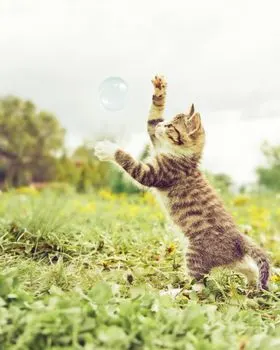 Bubbles are safe for cats as long as the soap is a non-toxic formula. Dishwashing liquid made with non-toxic elements is a safe way to make your bubbles at home.
Bubbles are safe for cats as long as the soap is a non-toxic formula. Dishwashing liquid made with non-toxic elements is a safe way to make your bubbles at home.
It is also possible to purchase specific bubbles intended for cats that are non-toxic and formulated with catnip oil.
Making your own bubbles at home is a great way to save money and create a quick game to entertain your cat.
Always be sure to thoroughly check the label on your dishwashing liquid to confirm the soap is safe for your pet.
Although non-toxic dishwashing liquid is safe to use and often makes smaller bubbles that reduce the amount of soap ingested, it can still cause your cat to become sick.
If your cat has ingested large quantities of bubbles or feels ill following pay time, contact the ASPCA Animal Poison Control Center for veterinary medical advice.
What Are Bubbles Made Of?
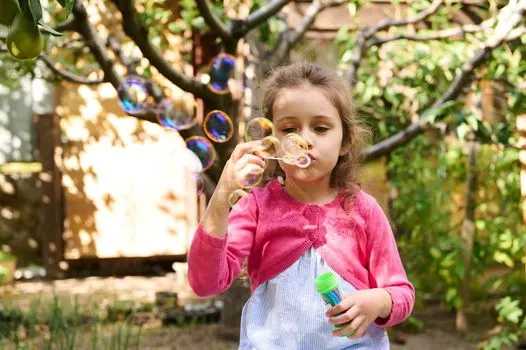 Most bubbles are made from some type of soap. The soap forms a film that traps air within, creating a perfectly spherical shape.
Most bubbles are made from some type of soap. The soap forms a film that traps air within, creating a perfectly spherical shape.
Most soaps are made by mixing together soap and water, but some bubbles contain fragrances or specific cat oils.
Some special cat bubbles may contain essential oils or even catnip. It is important to remember that while most bubbles are safe for cats, not all bubbles are safe and may contain toxic detergents.
Are Bubbles Safe for Other Pets?
Bubbles may be a fun game for cats to play and enjoy, but what if you have other pets in the house? It is vital to make sure that bubbles are safe for all family members.
When choosing bubbles, be sure to find a brand and mixture that is specifically intended for pets. There are some safe cat bubbles that contain essential oils and catnip.
If you have dogs in your home, a blanket pet-safe bubble blend is probably the safest route. Many pet bubbles are branded specifically as non-toxic bubble options.
Of course, always supervise your pets with bubbles to ensure a minimal amount of the soap is ingested.
How Do I Know If a Soap Is Safe?
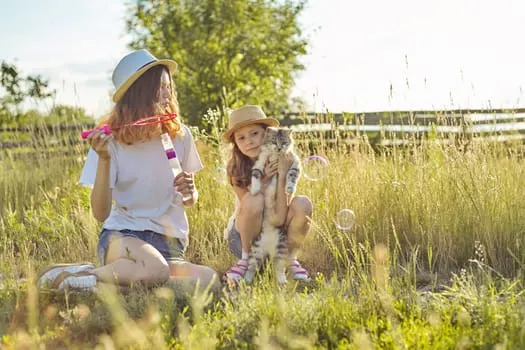 If you are making your own bubbles for your cat to play with, it is usually safe to use dishwashing liquid. Make sure the dishwashing liquid is non-toxic.
If you are making your own bubbles for your cat to play with, it is usually safe to use dishwashing liquid. Make sure the dishwashing liquid is non-toxic.
Carefully read the label before making bubbles to ensure that you are not inadvertently harming your cat. It is perfectly safe to mix some catnip oil into the bubble mix but use the oil sparingly.
Dishwashing liquid usually makes smaller bubbles which can help reduce the amount of soap ingested. You want to minimize the amount of bubble play you engage in with any bubble.
While bubbles are fun, too much of a good thing can cause your cat problems. Ingesting too many, even non-toxic, bubbles can cause your cat to have stomach pains.
Further, too much soap and oil collecting on your cat’s fur can cause more intestinal distress as your cat cleans its coat, licking the detergent.
Why Do Cats Like Bubbles?
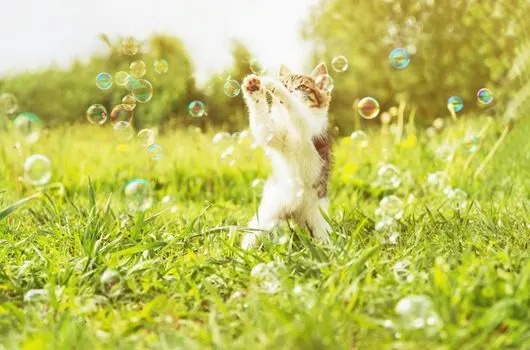 Cats can be picky about which toys they choose to play with, but it seems bubbles are always a popular option with cats.
Cats can be picky about which toys they choose to play with, but it seems bubbles are always a popular option with cats.
No matter how domesticated they have become, all cats can tap into their natural prey drive. Cats enjoy observing, stalking, and pouncing on moving targets because it mimics hunting.
Hunting not only keeps cats mentally engaged but uses incredible strength and agility, making it a suitable form of exercise. Bubbles are floating, unpredictable spheres that give cats a chance to hunt, even inside the house.
Bubbles have a rewarding pop when the cat catches them, and the activity is easily repeatable with different movements and patterns.
Plus, bubbles can be a solo activity or a great game for multiple cats to play together with you.
How Can I Make My Own Bubbles for My Cat?
Creating your own bubbles is easy and affordable. You’ll need a few basic supplies to start, including:
- Water
- Non-toxic dishwashing liquid
- Plastic Bottle
- Bubble Wand
To start, mix the dishwashing liquid and water. You want to add enough soap to the water without making the water too bubbly.
A good ratio is six cups of water for every cup of dishwashing soap. Add the mixture to the plastic bottle.
Dip the wand into the bottle and simply blow through the wand to produce tiny and safe bubbles for your cat.
What Are Catnip Bubbles?
 A quick internet search for bubbles or a trip to the pet store may produce a pet-friendly bubble option called catnip bubbles. These are specific bubbles that are designed for cats. The bubbles contain a liquid, non-toxic bubble solution with a bit of catnip oil extract added to the mix. Cats are usually more entertained with catnip bubbles, and it can help keep them more engaged. Catnip bubbles are a safe option and are always non-toxic for cats and other pets in your home.
A quick internet search for bubbles or a trip to the pet store may produce a pet-friendly bubble option called catnip bubbles. These are specific bubbles that are designed for cats. The bubbles contain a liquid, non-toxic bubble solution with a bit of catnip oil extract added to the mix. Cats are usually more entertained with catnip bubbles, and it can help keep them more engaged. Catnip bubbles are a safe option and are always non-toxic for cats and other pets in your home.
Are There Soaps to Avoid?
While most dishwashing liquid is non-toxic, you need to be careful when choosing a soap to make your own bubble mixture.
Keeping your pet safe is the utmost priority, allowing playtime to be a fun, safe, and rewarding adventure. Try to avoid bubbles that include:
- Soaps – Real soaps are usually safe for cats, but they can cause intestinal distress leading to diarrhea and vomiting. Try to avoid bar soap, laundry soap, and homemade soaps that may contain added fragrances and chemicals. Homemade soap is usually corrosive and can irritate the stomach and intestines.
- Detergents – Stay away from any detergent that is an anionic detergent. This detergent includes electric dishwashing detergents, shampoo, and laundry detergent. These soaps can cause quite a stomach ache and lead to diarrhea and vomiting if ingested. Exposure to the eyes can lead to swelling or conjunctivitis.
- Cationic Detergents – Soaps that fall under the cationic detergent category usually include petroleum-based products, sanitizers, fabric softeners, and disinfectants. These are incredibly toxic soaps that should be avoided at all costs. Even diluted solutions can cause serious damage to your pet. If you have accidental poisoning, you’ll see signs of vomiting, drooling, muscle weakness, and lack of appetite. Contacting the skin can cause irritation, and eye exposure can lead to ulcers or eye infections. It is imperative to contact your emergency veterinary center if accidental ingestion occurs with cationic detergents.
- Non-Ionic Detergents – This category of detergents presents a bit of a gray area, with any dishwashing, laundry detergents, and shampoos classed as non-ionic detergents. Usually, these detergents are not as toxic as cationic and anionic detergents. If accidentally ingested, symptoms typically include vomiting and diarrhea. Most non-ionic detergents are only considered mildly toxic for pets.
What should I do if my cat is sick after eating bubbles?
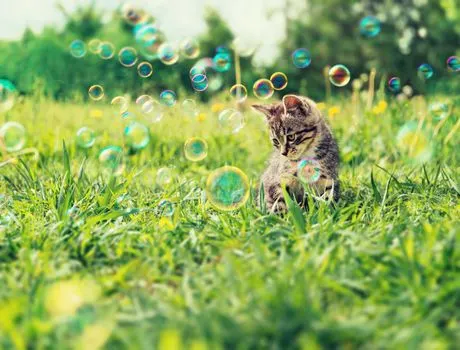 While bubbles are usually safe for cats, there is a risk that your cat could become sick if it ingests too many bubbles.
While bubbles are usually safe for cats, there is a risk that your cat could become sick if it ingests too many bubbles.
Aside from eating bubbles out of the air as your cat hunts and pounces, bubbles could land on your pet’s fur.
As your pet performs routine grooming, it may inadvertently lick the soap, causing irritation and possible stomach irritation.
Further, contact with the skin or eyes could cause irritation, fur loss, or possible eye infection.
Do not induce vomiting in your cat, as this may make the symptoms worse. Instead, contact the ASPCA Animal Poison Control Center.
This valuable resource will be able to identify the specific detergent used in the bubbles and provide helpful veterinary advice to get your cat feeling better again.
Related Questions
What simple interactive toys can I use to encourage play with my cat?
There may be plenty of battery-powered, pricey toys available for your cat to play with, but there are also plenty of simple toys that can keep cats entertained for hours.
Cats are natural hunters that enjoy thinking through situations. Presenting simple toys, like a paper bag, cardboard box, or even food puzzles, are easy ways to keep your cat thinking and exercising.
If you use supervision, cats may even like a fish tank to watch, as they can follow the movements of the fish.
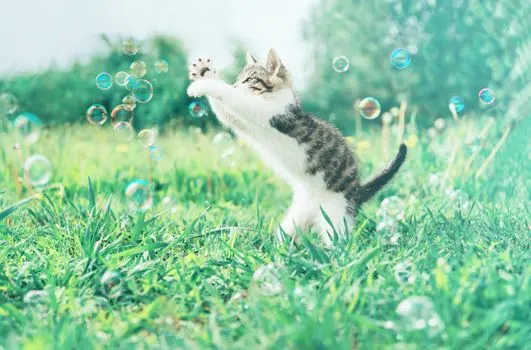 How much playtime does a cat need?
How much playtime does a cat need?
Keeping your cat well-exercised will not only help keep your cat healthy, but it will help keep your cat mentally stimulated and happy.
On average, a cat will need about 15 to 20 minutes of playtime every day. You can use a variety of cat toys or choose cat-safe bubbles to tap into your cat’s natural prey drive and hunting instincts.
Related Guides
Our team is composed of pet care professionals, veterinarians, and pet owners. To date, we’ve conducted thousands of hours of research to publish the most accurate pet information.
Most of the writers on our site are vets with 10+ years of clinical experience, ranging from small practice, to equine practice, academia, and surgery. Our goal is to help every pet owner get the information they seek about their dear companions.

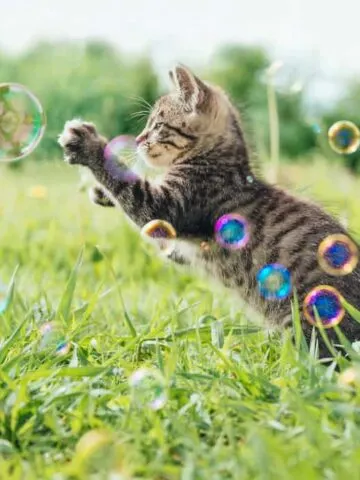

Leave a comment
You must be logged in to post a comment.